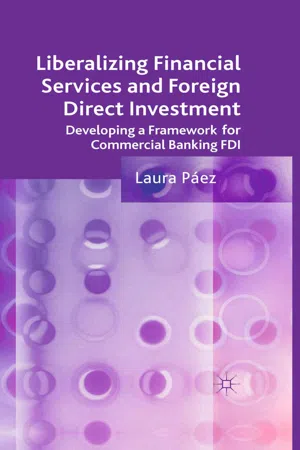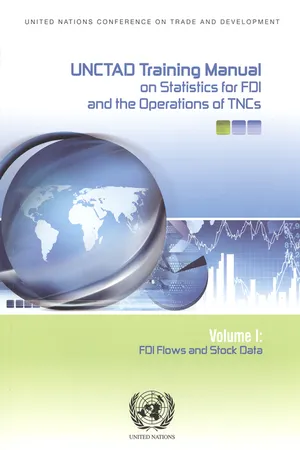Marketing
Direct investment
Direct investment refers to the acquisition of a controlling interest in a company or business entity by a foreign investor. This involves a substantial level of influence and control over the operations and management of the invested entity. Direct investment typically entails a long-term commitment and can involve various forms such as mergers, acquisitions, and establishing new facilities.
Written by Perlego with AI-assistance
Related key terms
1 of 5
5 Key excerpts on "Direct investment"
- eBook - PDF
- Greg Elliott, Sharyn Rundle-Thiele, David Waller, Ingo Bentrott, Siobhan Hatton-Jones, Pete Jeans(Authors)
- 2020(Publication Date)
- Wiley(Publisher)
They may make a Direct investment by establishing a greenfields operation (a new business from the ground up), buying out a strategic ally or even a competitor or buying a business somewhere up or down the supply chain (e.g. a manufacturing plant or a retailer). Businesses that develop extensive directly owned assets in numerous foreign countries are known as multinational corporations. Directly owned subsidiaries may operate with little or considerable autonomy depending on the nature of the foreign market and the business’s products. If the target international market is dissimilar to the parent business’s market, the subsidiary may be given wide‐ranging freedom to customise its products, marketing mix and business operations, taking advantage of the local know‐how of its management. Success will then CHAPTER 13 International marketing 423 lead to greater autonomy. Such businesses also need to maximise cooperation and standardisation where possible though, to ensure they benefit from economies of scale and cumulative wisdom. The inconsistencies and vagaries of laws around the world make direct ownership approaches to international marketing very complex, but also potentially very lucrative. Entire industries are built around finding the best countries to undertake different functions. For example, diamond companies have, naturally, subsidiaries in countries with rich deposits; while it may be an interesting ethical debate, the reality is that many businesses are headquartered in tiny island nations that do not charge corporate tax; and many manufacturing operations are located in countries with few laws to protect workers. Born global The preceding sections have discussed the various ways that a business may enter a foreign market or evolve its foreign marketing operations to ever‐greater levels of commitment. Before leaving this discussion we will briefly consider the phenomenon of businesses that are ‘born global’. - Richard Schaffer, Filiberto Agusti, Lucien Dhooge, , Richard Schaffer, Filiberto Agusti, Lucien Dhooge(Authors)
- 2017(Publication Date)
- Cengage Learning EMEA(Publisher)
Similarly, participation in manufacturing or marketing joint ventures based in foreign host countries is foreign Direct investment. Foreign Direct investment can also allow the investor to avoid trade barriers in certain cir-cumstances. Direct investment may also be necessary to acquire the right to use intellectual property. Investing in many different countries can have a diversification benefit—a booming economy in host country can make up for poor performance in the economy of the inves-tor’s home country. Methods of Foreign Direct investment Just as there are many possible motives for making an investment in a foreign country, there are many forms that such an investment can take. This section outlines the classic methods of foreign Direct investment and explores the different legal consequences that attach to each. The discussion begins with a review of the forms that grant the U.S. investor the most direct control over the enterprise created by the investment, and proceeds to an exploration of the rationale for choosing among these forms. Opening a Foreign Branch or Forming a New Foreign Subsidiary. An enterprise that wishes to establish an entity abroad under its control may create a subsidiary (a separate corporate entity organized under the laws of the foreign host country) or a branch (a division of the home country corporation that is not a separate legal person). Neither step is to be taken lightly. Whether the company establishes a subsidiary or a branch, it may waive rights of protection under the bilateral invest-ment protection agreements of the United States. In many cases, the company also subjects itself completely to the foreign nation’s corporate tax laws. Certain differences distinguish the subsidiary from the branch approach. If a company chooses to estab-lish a branch abroad, it faces greater potential vicari-ous liability.- eBook - PDF
Liberalizing Financial Services and Foreign Direct Investment
Developing a Framework for Commercial Banking FDI
- L. Páez(Author)
- 2011(Publication Date)
- Palgrave Macmillan(Publisher)
2 Correspondingly, a definition of FDI will reflect these statistical and legal discrepancies. Nonetheless, a concept that has had grow- ing acceptance in an important number of countries is the OECD Benchmark definition. This definition is consistent with the IMF Balance of Payments Manual and has also been systematically taken up by the United Nations Conference for Trade and Development (UNCTAD) in its World Investment Report. 3 The OECD defines foreign Direct investment as follows: Foreign Direct investment reflects the objective of obtaining a last- ing interest by a resident entity in one economy (“direct investor”) Understanding FDI 9 in an entity resident in an economy other than that of the investor (“Direct investment enterprise”). The lasting interest implies the existence of a long-term relationship between the direct inves- tor and the enterprise and a significant degree of influence on the management of the enterprise. Direct investment involves both the initial transaction between the two entities and all sub- sequent capital transactions between them and among affiliated enterprises, both incorporated and unincorporated. 4 As the word foreign denotes, foreign Direct investment is a cross-bor- der transfer of capital from a source to a host country. In essence, FDI reflects an interest on behalf of the “direct investor” to seek establishment in the host country through a “Direct investment enterprise.” Further, this interest is accompanied by the objective to exercise some form of control over the investment, since the investor holds “a significant degree of influence on the management of the enterprise.” Two important considerations arise in the context of this defini- tion. First, how much FDI is required to qualify establishment of an enterprise as a Direct investment enterprise? Second, to what extent does the direct investor have an influence over the enterprise management? These questions can be answered when ownership control is addressed. - eBook - PDF
- John Edwards(Author)
- 2019(Publication Date)
- Taylor & Francis(Publisher)
5 Foreign Private Investment The stagnation of the volume of official development assistance and the contraction of voluntary bank lending to developing countries have highlighted the question of how the continuing external financial needs of the developing countries can be met. In this context, increasing attention is being given to the possibilities for augmenting other flows of foreign capital, primarily Direct investment but also portfolio equity investment. The Baker initiative, announced on October 8, 1985, em-phasized the vital role that foreign private investment can play as part of a comprehensive program to restore healthy economic growth in the Third World. I Direct inPestment is defined as flows of capital from a parent company to a foreign affiliate. It can include new equity capital, reinvested earnings, or net lending by the parent to the affiliate. The distinguishing characteristic of Direct investment is the acquisition of a lasting interest and an effective voice in the management of a foreign enterprise. In contrast, portfolio equity inPestment consists of the acquisition of a share of ownership without an effective influence in the policies or management of an enterprise. Portfolio equity capital has not been important as a source of external finance for developing countries m recent years, but it may have significant potential in the future. Attitudes Toward Direct investment Foreign Direct investment has been regarded with deep suspicion in much of the developing world. Fear of economic exploitation and political domination by powerful multinational corporations has colored attitudes and has conditioned host-country policies and regulations. As a result, severely restrictive conditions often face the foreign investor. In some developing countries, however, a greater receptivity to foreign investment has emerged. This change reflects an intellectual reassessment of the threats posed by foreign companies as well as the benefits they 77 - No longer available |Learn more
- (Author)
- 2011(Publication Date)
All real estate investment of a private, non- business nature, covering such areas as recreational facilities, vacation homes and residences owned by non-residents for personal use or leased to others should, in principle, be included in Direct investment (IMF, 1993, paragraph 382). Some of this investment would be conducted through unincorporated entities in an economy. Box I.32. FDI in the banking sector FDI in banks and other financial intermediaries is limited to transactions associated with equity (share capital) and permanent debt. a Permanent debt consists of long-term loans, bonds and debentures, and other such long- term debt liabilities extended by a foreign bank to an affiliated bank in another economy. Equity capital is considered a long-term investment. There may be all types of liabilities by a Direct investment enterprise in the banking sector with its foreign parent or other foreign affiliates. The liabilities considered as Direct investment would be those that are normally included in the long- term liability or debt portion of the balance sheet. Branches are also included in this type of treatment where the fixed assets of the banks are considered as Direct investment. The other liabilities by depository institutions with foreign affiliates would be treated as appropriate, as either portfolio investment or other investment. This would include the usual transactions, such as deposits and other claims, that take place between banks and depository institutions. a Under the fourth edition of the Benchmark Definition (BD4), permanent debt is no longer considered an FDI item (OECD, 2008). VOLUME I | 67 Box I.33. FDI in natural resource exploration Expenditures of Direct investment enterprises for the exploration of natural resources would be recorded as Direct investment inflows where the expenditures are financed by the direct investor.
Index pages curate the most relevant extracts from our library of academic textbooks. They’ve been created using an in-house natural language model (NLM), each adding context and meaning to key research topics.




